Customise with Tools Customize Menu
TDF LibreOffice Document Liberation Project Community Blogs Weblate Nextcloud Redmine Ask LibreOffice Donate
This page is in work!
Foreword
This video shows how under LibreOffice the menu ▸ menu can be applied. The menu ▸ menu can be found in all components of LibreOffice. This description is based on the example of the Writer component and refers to this page here for more information and details.

Once you have opened the menu, six tabs are displayed in the Customize dialog.
You can therefore make customizations
- in the Menus
- in Toolbars
- in Notebookbar
- in Context Menus
- for Keyboard shortcuts
- and for Events
Link to the Video
Link to the Video (in German [DE]):
Menü Extras Anpassen - LibreOffice This video is in work!
For example, open Writer.
Choose the ▸ menu.
Depending on what you want to customize, select one of the following tabs:
| Menus | Toolbars | Notebookbar | Context Menus | Keyboard | Events |
Customize means that you can add or remove an "Available Command" from one of these options.
See also in the online help:
Customize Menus
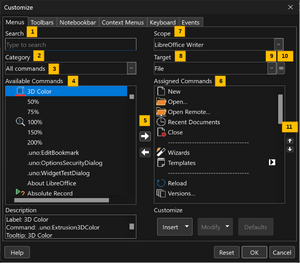
Choose ▸ from the menu.
The "Customize" dialog will open.
Click on the "Menus" tab (Figure 1).
Left side of the dialog
The "Customize" dialog tab "Menus" is divided on the left side so that you can select an available command and add it to an existing menu.
You can select a command using Search 1, for this you enter a string in the text field to narrow down the search for commands.
Or you can select a thematic group of commands at Category 2.
If "All Commands" 3 is selected at Category, you can scroll all commands at Available Commands 4 and select one.
When you have selected your desired command, you can add it to the displayed menu.
Add/remove entries
In the middle of the dialog there are two arrows 5 Add entry ![]() /
/ ![]() Remove entry.
Remove entry.
With the arrow ![]() you can return Assigned commands 6 to Available commands.
you can return Assigned commands 6 to Available commands.
With the arrow ![]() you can assign Available Commands to Assigned Commands.
you can assign Available Commands to Assigned Commands.
So when you have selected your desired command, click on the arrow ![]() so that it is inserted into the right side of the dialog.
so that it is inserted into the right side of the dialog.
Right side of the dialog
On the right side you can select the Scope 7, Writer or only the document, for which the adjustment should be valid.
Below that you can select the Target 8, which is the menu or submenu where the customization should be made.
If you click on the arrow next to the Target 9 entry, you will get a list of menus and submenus to choose from.
To the right of this arrow is a hamburger menu 10 with choices that vary by situation.
And in the next field below, you will find the existing Assigned Commands of the selected menu.
To the right of it there are two arrows 11 ![]() /
/ ![]() .
.
For example, if you mark the new command inside the Assigned Commands, you can use the arrows ![]() /
/ ![]() to move the command.
to move the command.
When you are done click .
The new command should now be visible for use in the previously selected menu.
See also in the online help: Menus
Customize Toolbars
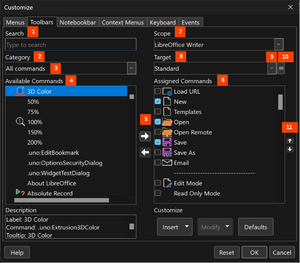
Choose ▸ from the menu.
The "Customize" dialog will open.
Click on the "Toolbars" tab (Figure 2).
Left side of the dialog
The dialog "Customize" tab "Toolbars" is divided on the left side so that you can select an Available command and add it to a toolbar.
You can select a command using Search 1, for this you enter a string in the text field to narrow the search for commands.
Or you can select a thematic group of commands at Category 2.
If "All Commands" 3 is selected at Category, you can scroll all commands at Available Commands 4 and select one.
When you have selected your desired command, you can add it to the displayed toolbar at Target.
Add/remove entries
In the middle of the dialog there are two arrows 5 ![]() /
/ ![]() .
.
With the arrow ![]() you can return Assigned Commands 6 to Available Commands.
you can return Assigned Commands 6 to Available Commands.
With the arrow ![]() you can assign Available Commands to Assigned Commands.
you can assign Available Commands to Assigned Commands.
So when you have selected your desired command, click on the arrow ![]() so that it is inserted into the right side of the dialog.
so that it is inserted into the right side of the dialog.
Right side of the dialog
On the right side you can select the Scope 7, for Writer or a document, for which the adjustment should be valid.
Below that you can select the Target 8, that is the toolbar, where the customization should be made.
If you click on the arrow 9, next to the displayed toolbar, you will get a list of toolbars to choose from.
To the right of this arrow 10 is a hamburger menu with the choices varying by situation.
And in the next field below you will find the existing Assigned commands of the selected toolbar.
To the right of it there are two arrows 11 ![]() /
/ ![]() .
.
For example, if you select the new command inside the Assigned Commands, you can use the arrows ![]() /
/ ![]() to move the command.
to move the command.
When you are finished click .
The new command should now be visible in the previously selected toolbar for use.
See also in the online help: Adding Buttons to Toolbars
Customize Notebookbar
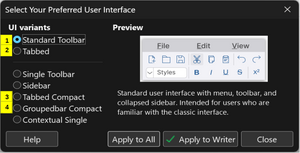
See also in the online help: User interface.
You can reach the relationship to the Notebookbars by selecting ▸ from the menu.
In the "Select Your preferred User Interface" dialog that then opens, select one of the options below the Toolbars selection 1
| "Tabbed" 2 | "Tabbed Compact"3 | "Groupedbar Compact"4 | (Figure 3).
See also: User interface in Writer
The menu ▸ "Notebookbar" tab refers to one of these user interface settings (Figure 4).
If none of the above user settings have been made, there will be no selection in the "Customize" dialog.
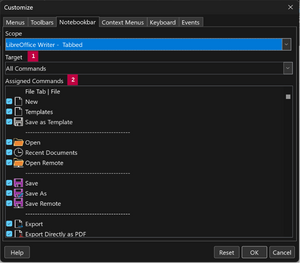
In the Target area 1, you can select either "All Commands" or sub-functions.
In the Assigned Commands 2 area, you can deselect or select commands by selecting or deselecting a checkbox (check/uncheck). (Figure 4)
The selected command should now be visible or hidden in the previously selected Notebookbar.
See also: Using Notebookbar
Customize Context Menus
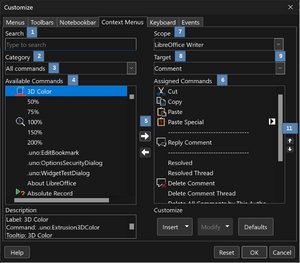
Choose ▸ from the menu.
The "Customize" dialog opens.
Click on the "Context Menus" tab. (Figure 5)
Left side of the dialog
The dialog "Customize" in the tab "Context menus" is divided on the left side so that you can select an Available command and add it to a Context Menu.
You can select a command using Search 1.
To do this, enter a string in the text field to narrow the search for commands.
Or you can select a thematic command group at Category 2.
If "All Commands" 3 is selected at Category, you can scroll all commands at Available Commands 4 and select one.
When you have selected your desired command, you can add it to the displayed context menu.
Add/remove entries
In the middle of the dialog there are two arrows 5 ![]() /
/ ![]() .
.
With the arrow ![]() you can return Assigned Commands to Available Commands.
you can return Assigned Commands to Available Commands.
With the arrow ![]() you can assign Available Commands to Assigned Commands.
you can assign Available Commands to Assigned Commands.
So, when you have selected your desired command, click on the arrow ![]() so that it will be inserted in the right side of the dialog.
so that it will be inserted in the right side of the dialog.
Right side of the dialog
On the right side you can select the Scope 7, for Writer or a document, for which the adjustment should be valid.
Below that you can select the Target 8, that is the Context Menu, where the customization should be made.
If you click on the arrow 9, next to the displayed Context Menu, you will get a list of Context Menus to choose from.
And in the next field below, you will find the existing Assigned Commands 6 of the selected context menu.
To the right of it 11 there are two arrows ![]() /
/ ![]() .
.
For example, if you highlight the new command inside the Assigned Commands, you can use the arrows to move the command.
When you are done click .
The new command should now be visible for use in the previously selected Context Menu.
See also in the online help: Context Menus
Customize Keyboard - Keyboard Shortcuts
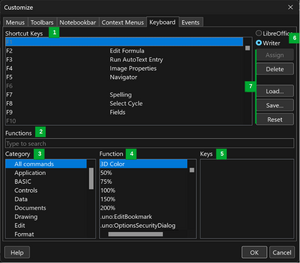
Choose ▸ from the menu.
The "Customize" dialog opens.
Click on the "Keyboard" tab. (Figure 6)
In the upper part of the "Customize" dialog are the keys and key combinations 1.
Some keys and key combinations are already assigned, but can be changed under certain circumstances.
Some keys and key combinations are displayed in light gray and cannot be used.
In the middle of the dialog you can search for Functions 2.
Below that is the area 3 and the functions 4 for the commands.
On the far right, the keys that you have marked for customization above are displayed 5.
In the upper right area of the dialog, you have the choice of whether you want to customize for LibreOffice or Writer 6.
Below that are the buttons 7 for , , , and .
The new command should now be assigned to the selected button or button combination in the upper part at button combinations and can be used.
See also in the online help: Keyboard
Customize Events
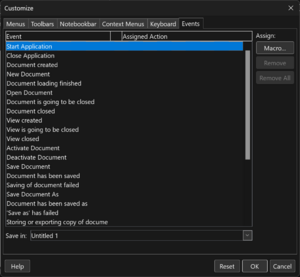
Choose ▸ from the menu.
The "Customize" dialog will open.
Click on the "Events" tab.
Here you can make assignments to actions (macros) to certain events. (Figure 7)
See also in the online help: Events
Further Informations
Topic book as a document for this wiki page
(In German [DE]) Common - Tools>Customize - Theme book
Documentation / Manuals
Here you will find the Documentation / Manuals:
Any questions?
For questions on this topic go to:
Get Involved
Join us today and help us to make it even better!
Donate
LibreOffice is Free Software and is made available free of charge.
Your donation, which is purely optional, supports our worldwide community.
If you like the software, please consider a Donation.